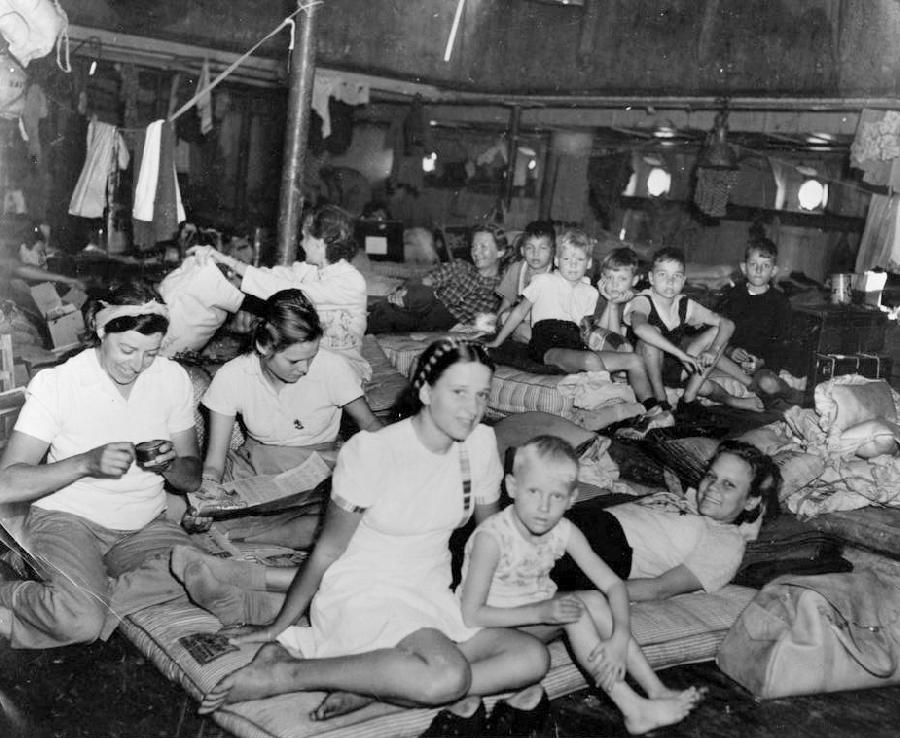
World War II: Dutch East Indies: Linberation of Japanese Internees (1944-45)

Figure 1.--Here is a group of the Dutch internees taken in March 1946, probably about 6 months after liberation. They had begun to recover from their ordeal and are headed for America to recuperate. The press caption read, "Peace to Forget Jap Horror Camps: Evacuees from Japanese prison camps. These Dutch people looked happy and well in spite of their 14-day voyage in the holds of the Dutch freighter 'Tjibadac? which yesterday brought them here for a six-months' holiday. The freighter, which has regular accommodations for 30 passengers, carried 430 evacuees, including 150 children."
|
|
The liberation of the DEI camps was not a uniform or easy process. Many camps were liberated as the forces were recapturing territory. The DWI was, however, a huge archipelago. There were countless islands and the Allies had limited resources to get to all of them quickly. The Allies used their expanding air power to strike at Japanese military targets in the DEI. Allied forces (Australian, Dutch, and Acehnese rebels) began to retake islands. The first islands taken were in the east, but the Allies eventually reached Sumatra. The Allied campaign included: Hollandia (April 22, 1944), Morotai (September 15 1944), Tarakan (April 30, 1945), Halmahera and northern Sumatra (June 1945). British Indian troops reached the infamous Tjideng camp in Batavia/Jakarta (September 1945). One by one the camps were liberating, but quite a number were still in Japanese hands when Emperor Hirohito announced the su
rrender. For these internees in the DEI, freedom did not occur until months after the Japanese surrender. The Americans dropped supplies by air in camps in Japan and China in an effort to get food and medical supplies to POWs and civilian internees before recovery teams could reach them. As far as we know, there was no similar effort in the DEI, although this needs to be confirmed. The Allies did not have the shipping to both get to the internees and to deploy troops to take over from the surrendering Japanese. And the Dutch internees faced the additional uncertainty of the Indonesian war of independence. Many wished to return to the Netherlands. Here again there was only limited transport available and many needs to be met.
CIH -- WW II

Navigate the CIH World war II Section:
[Return to Main liberation of Japanese internees in the DEI page]
[Return to Main Japanese mistreatment of civilian internees page]
[Return to Main World War II Indonesian Page]
[Return to Main World War II country page]
[Return to Main World War II Japanese conquests page]
[Return to Main World War II Pacific Naval campaign page]
[Biographies]
[Campaigns]
[Children]
[Countries]
[Deciding factors]
[Diplomacy]
[Geo-political crisis]
[Economics]
[Home front]
[Intelligence]
[POWs]
[Resistance]
[Race]
[Refugees]
[Technology]
[Bibliographies]
[Contributions]
[FAQs]
[Images]
[Links]
[Registration]
[Tools]
[Return to Main World War II page]
[Return to Main war essay page]
Created: 7:53 AM 12/13/2013
Spell checked: 5:16 PM 12/13/2013
Last updated: 5:16 PM 12/13/2013



